This ISO21500: 20121 (hereafter simply referred to as ISO2012) based Praxis method comprises the seven processes from the international standard’s integration subject area. The most obvious difference is that the word ‘project’ has been removed as the model can be applied to programmes as well as projects. (Note: because ISO21500 is very closely based on the PMBoK®2 6th Edition this method is also broadly consistent that document).
The diagram below also shows how ISO21500 allocates these processes within its five process groups.
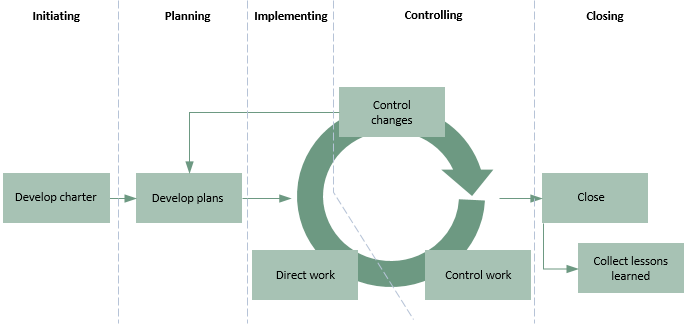
These processes align with the basic project and programme life cycle as shown below. The develop charter process only covers part of the identification phase, as it is defined by Praxis. Hence the split shown in the diagram.
In ISO21500 the early part of the identification phase is deemed to be performed by the host organisation before the existence of a project or programme is officially recognised.
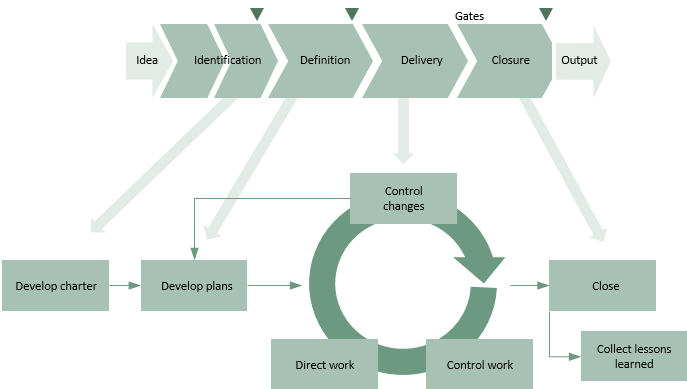
ISO21500 uses the term ‘project’ in its process names, e.g. ‘develop project charter’. However, it also clearly states that: “To manage a project throughout its life cycle, project management processes should be used for the project as a whole or for individual phases for each team or sub-project.”
It is a key principle of ISO21500 that the management processes should be applied not only at the level of the project life cycle but also at the level of sub-divisions of the project. As with the primary Praxis method, this alternative method takes the view that what works for a project and its components will also work for a programme and its components.
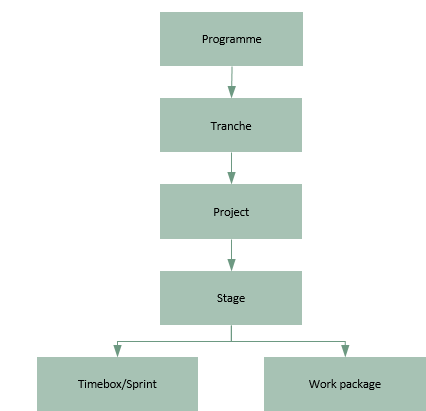 The terminology around the progressive breakdown of work can get very confusing. Praxis simplifies this into the structure opposite:
The terminology around the progressive breakdown of work can get very confusing. Praxis simplifies this into the structure opposite:
Starting at the top, a programme is a typically complex undertaking that includes multiple projects, multiple outcomes and multiple benefits with many to many relationships between them. The nature of cause and effect cannot always be predicted.
Programmes are typically broken down into tranches that comprise a number of interrelated projects and larger projects will be broken down into stages. Stages may be broken down into work packages or timeboxes (also known as sprints). The latter is the preferred approach in agile projects.
When describing the processes, this section will refer to ‘projects and programmes’ but this should be taken to include any other element within the hierarchy.
Extending this principle means that the same seven processes are applicable from programme down to work package, albeit the detail of how they are applied at each level will vary. The one exception to this is timeboxes as these use iterative development processes that are more suited to contexts where there is high uncertainty of scope.
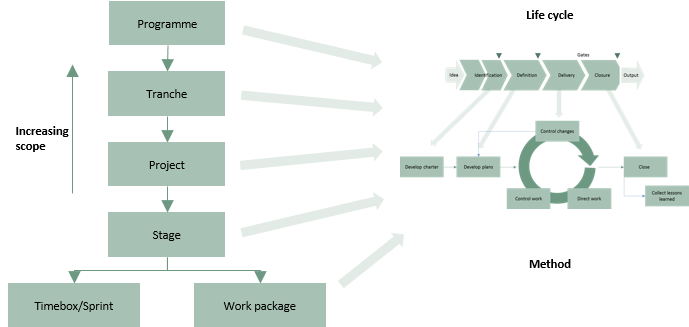
Neither ISO21500 nor the PMBoK® Guide include processes for sponsorship of the project or programme, or the realisation of benefits. This Praxis version of the approach borrows both those processes from the primary method.
This results in the process model shown below.
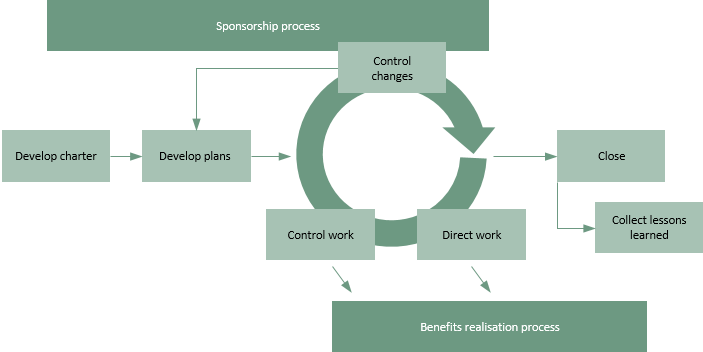
In contrast to the processes described in the primary Praxis process model, the processes in this alternative approach do not contain linked activities that need to be performed to complete the process. Instead, each process shows the inputs and outputs, and the functions (from the Praxis knowledge section) that the process needs to apply in order to use the inputs and create the outputs.
ISO21500 is a very high level framework where a lot of detail needs to be added in order to make it effective in practice. That detail has been added by drawing upon the closely related PMBoK® Guide and also on the primary Praxis method. The latter is particularly influential in giving the alternative method more robust governance through the role of the sponsor and ensuring that benefits realisation is covered.
In this alternative method, each ISO21500 integration process is described in terms of its inputs and outputs (taken directly from the standard) and the functions it applies in order to produce the outputs from the inputs. These functions are taken from the knowledge section of the Praxis Framework.

As well as the integration subject group that is used to manage the life cycle, ISO21500 contains a further nine subject areas. Each subject area contains a number of processes. These equate to the functions and their component procedures in Praxis. The ISO21500-Praxis maps show how the ISO21500 processes relate to the procedures in the corresponding Praxis functions.
Click on any subject group in the table below to see a detailed mapping of the two approaches.
| ISO21500 subject groups | Praxis functions |
|---|---|
Praxis takes a similar approach to ISO10006 ‘Guidelines for quality management in projects’ in that quality is seen as inherent in all the processes and is not a separate subject. | |
Stakeholder management |
The result is a life cycle method that uses Praxis to provide sufficient supporting detail to manage a project or programme and contribute towards the capability maturity of an organisation.
- ISO21500: 2012, published by the International Standards Organisation (ISO)
- The PMBOK® Guide, published by the Project Management Institute (PMI®)





